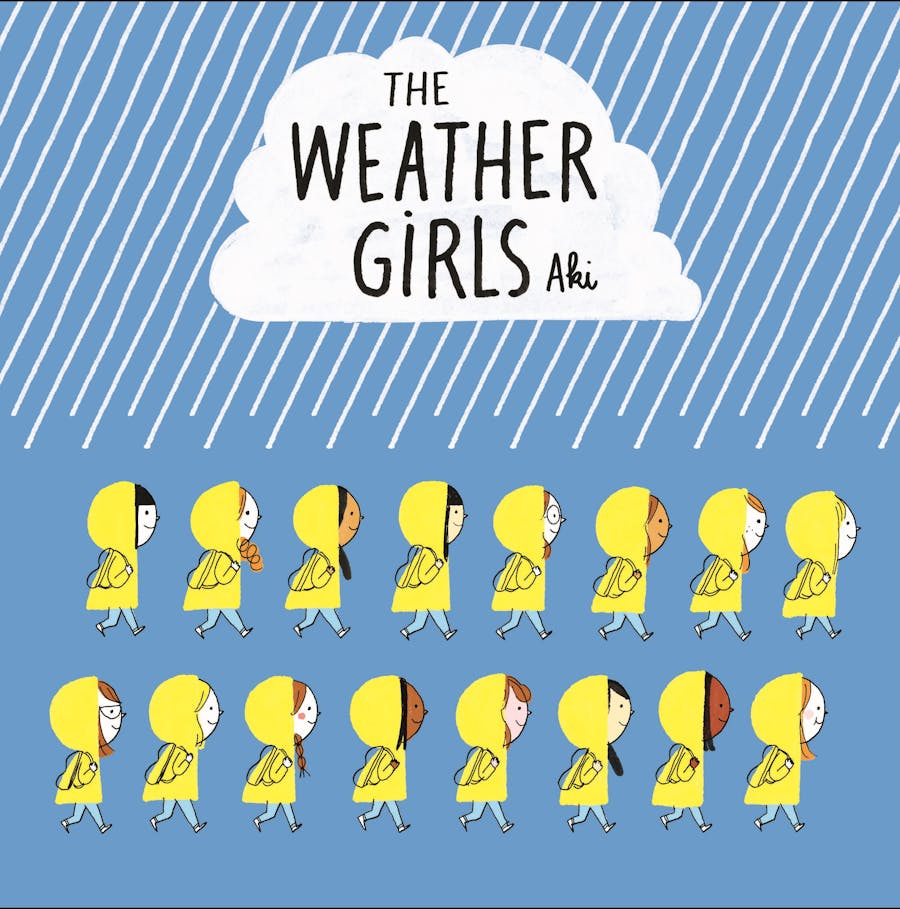The Weather Girls by Aki. Published by Henry Holt and Co., 2018.

- Summary – This bright and cheerful picture book follows (exactly) 16 little girls on a romp through the four seasons, as they experience Summer, Autumn, Winter, and Spring. Colorful typography is used to accent important words in the rhyming narration, echoed by playful, semi-lineless digital spreads that sprawl across each page. The Weather Girls shows not only the physical and atmospheric changes between seasons, but also that there is always something any child can enjoy about each special time of year.
- Target Audience – Interest-wise, the target audience range for this book is ages 2-5, however I should clarify that the earlier readers within this range will likely need an adult to read together with them until they are a sufficiently independent reader. That said, in terms of content and visual appeal, sentences are still relatively short and simple, while expert use of bright colors and patterns make this an engaging sensory story for young readers. This being a picture book, it’s likely too simplified for most older independent readers who want more of a plot structure.
- Strengths and Weaknesses- One particular strength of this work is its positive and optimistic tone. While there is no direct dialogue between characters, readers will feel themselves drawn in to each scene as the action of all the girls at play is allowed to speak for itself, like the spread on pg. 12-13 that shows them admiring gold and red leaves or building a snowman in the cold of Winter on pg. 18. The idea of finding something different to love in everything, maybe even the seasons that aren’t our favorites, is a throughline theme in the story. (I could find no obvious weaknesses with this story; it all came together quite seamlessly.)
- Creative uses– There is a section at the back of the book labeled “Meet the Seasons” that recaps some of the details about each season’s weather and other attributes in a more strictly informational way than in the story alone. Depending on what season it is, you could use this book to ask children questions about the weather you are currently experiencing, using basic concepts like opposites. Is it hot or cold? Mostly cloudy or sunny? Rainy or snowy? and so on. You could also use a flannel board to describe it visually (creating a scene with sun and clouds, different tree leaves, snow, or flowers, etc) to show what changes with each season. You could also feature this book in a weather or season-themed storytime, or even in a nature storytime.
Read-Alikes
- Ava and the Rainbow (Who Stayed) by Ged Adamson – This imaginative picture book tells the story of a girl named Ava who wishes a beautiful rainbow would always stay in the sky. Her wish is granted, but after a while, the Rainbow stops being special to the people of her town – is anything really meant to last forever? This story blends a bright rainbow of watercolors with digital techniques to demonstrate that readers shouldn’t take nature’s wonders for granted. This story, like The Weather Girls celebrates the ephemeral beauty of weather and change.
- If Winter Comes, Tell It I’m Not Here by Simona Ciraolo – This picture book follows the snowballing worries of one little boy that “everything will change” when Summer becomes Winter. He expresses his trepidations and sadness at leaving summer behind, while simultaneously realizing there are fun parts of Autumn and yes, even Winter. The empathetic and optimistic tone of this story would make for a great pairing with The Weather Girls, especially for children who may also be anxious about saying goodbye to their favorite time of year. Both books serve as a bright thematic reminder that because seasons change, there is always something new to enjoy.
- Goodbye Summer, Hello Autumn by Kenard Pak – This call-and-response between a child and different aspects of nature (like bugs, animals, flowers, leaves, etc.) follows the shift from Summer into Fall. Not only does the meditative and calm release from one season to the next emphasize the natural aspect of change, with a repeated mantra of “Hello” until the last “Goodbye”, but Pak subtly shifts the color palette from lively greens to earthy oranges and browns as the weather changes too. The Weather Girls would pair well with the tranquil, first-person collective perspective of this book especially well, as both emphasize embracing the big changes that occur in the world around us, outside of our control.